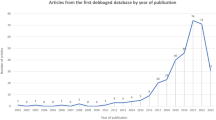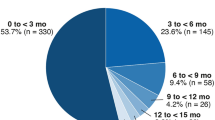Abstract
Current administration of ranibizumab and other therapeutic macromolecules to the vitreous and retina carries ocular risks, a high patient treatment burden, and compliance barriers that can lead to suboptimal treatment. Here we introduce a device that produces sustained release of ranibizumab in the vitreous cavity over the course of several months. Composed of twin nanoporous polymer thin films surrounding a ranibizumab reservoir, these devices provide release of ranibizumab over 16 weeks in vitro and 12 weeks in vivo, without exhausting the initial drug payload. Following implantation in vivo, devices were well-tolerated and showed no sign of immune response. This platform presents a potential solution to the challenge of delivering protein therapeutics to the vitreous and retina for sustained periods of time.





Similar content being viewed by others
References
Schwartz GF. Compliance and persistency in glaucoma follow-up treatment. Curr Opin Ophthalmol. 2005;16:114–21. doi:10.1097/01.icu.0000156139.05323.26.
Reardon G, Kotak S, Schwartz GF. Objective assessment of compliance and persistence among patients treated for glaucoma and ocular hypertension: a systematic review. Patient Prefer Adherence. 2011;5:441–63. doi:10.2147/PPA.S23780.
Ranta V-P, Mannermaa E, Lummepuro K, Subrizi A, Laukkanen A, Antopolsky M, et al. Barrier analysis of periocular drug delivery to the posterior segment. J Control Release. 2010;148:42–8. doi:10.1016/j.jconrel.2010.08.028.
Boddu SH, Gupta H, Patel S. Drug delivery to the back of the eye following topical administration: an update on research and patenting activity. Recent Pat Drug Deliv Formul. 2014:27–36. doi:10.2174/1872211308666140130093301.
Maurice DM. Drug delivery to the posterior segment : an update. Retin Today. 2013;47.
The CATT Research Group. Ranibizumab and bevacizumab for neovascular age-related macular degeneration. N Engl J Med. 2011;364:1897–908 .http://www.mendeley.com/research/ranibizumab-bevacizumab-neovascular-agerelated-macular-degeneration/. Accessed 14 Apr 2012
Heier JS, Brown DM, Chong V, Korobelnik JF, Kaiser PK, Nguyen QD, et al. Intravitreal aflibercept (VEGF trap-eye) in wet age-related macular degeneration. Ophthalmology. 2012;119:2537–48. doi:10.1016/j.ophtha.2012.09.006.
Varma R, Bressler NM, Suñer I, Lee P, Dolan CM, Ward J, et al. Improved vision-related function after ranibizumab for macular edema after retinal vein occlusion: results from the BRAVO and CRUISE trials. Ophthalmology. 2012;119:2108–18. doi:10.1016/j.ophtha.2012.05.017.
Nguyen QD, Brown DM, Marcus DM, Boyer DS, Patel S, Feiner L, et al. Ranibizumab for diabetic macular edema. Ophthalmology. 2012;119:789–801. doi:10.1016/j.ophtha.2011.12.039.
Ghasemi Falavarjani K, Nguyen QD. Adverse events and complications associated with intravitreal injection of anti-VEGF agents: a review of literature. Eye. 2013;27:787–94. doi:10.1038/eye.2013.107.
Townsend D, Reeves BC, Taylor J, Chakravarthy U, O’Reilly D, Hogg RE, et al. Health professionals’ and service users’ perspectives of shared care for monitoring wet age-related macular degeneration: a qualitative study alongside the ECHoES trial. BMJ Open. 2015;5:e007400. doi:10.1136/bmjopen-2014-007400.
Amoaku W, Blakeney S, Freeman M, Gale R, Johnston R, Kelly SP, et al. Action on AMD. Optimising patient management: act now to ensure current and continual delivery of best possible patient care. Eye (Lond). 2012;26(Suppl 1):S2–21. doi:10.1038/eye.2011.343.
Busbee BG, Ho AC, Brown DM, Heier JS, Suñer IJ, Li Z, et al. Twelve-month efficacy and safety of 0.5 mg or 2.0 mg ranibizumab in patients with subfoveal neovascular age-related macular degeneration. Ophthalmology. 2013;120:1046–56. doi:10.1016/j.ophtha.2012.10.014.
Rawas-Qalaji M, Williams C-A. Advances in ocular drug delivery. Curr Eye Res. 2012;37:345–56. doi:10.3109/02713683.2011.652286.
Kang-Mieler JJ, Osswald CR, Mieler WF. Advances in ocular drug delivery: emphasis on the posterior segment. Expert Opin. Drug Deliv. 2014;5247:1–14. doi:10.1517/17425247.2014.935338.
Kuppermann BD, Blumenkranz MS, Haller JA, Williams GA, Weinberg DV, Chou C, et al. Randomized controlled study of an intravitreous dexamethasone drug delivery system in patients with persistent macular edema. Arch Ophthalmol. 2007;125:309–17. doi:10.1001/archopht.125.3.309.
Bhagat R, Zhang J, Farooq S, Li X-Y. Comparison of the release profile and pharmacokinetics of intact and fragmented dexamethasone intravitreal implants in rabbit eyes. J Ocul Pharmacol Ther. 2014;30:854–8. doi:10.1089/jop.2014.0082.
Kane FE, Burdan J, Cutino A, Green KE. Iluvien: a new sustained delivery technology for posterior eye disease. Expert Opin Drug Deliv. 2008;5:1039–46. doi:10.1517/17425247.5.9.1039.
Pardo-López D, Francés-Muñoz E, Gallego-Pinazo R, Díaz-Llopis M. Anterior chamber migration of dexametasone intravitreal implant (Ozurdex®). Graefe’s Arch Clin Exp Ophthalmol. 2012;250:1703–4. doi:10.1007/s00417-011-1802-x.
Vela JI, Crespí J, Andreu D. Repositioning of dexamethasone intravitreal implant (Ozurdex®) migrated into the anterior chamber. Int Ophthalmol. 2012;32:583–4. doi:10.1007/s10792-012-9604-7.
Wai Ch’ng S, Padroni S, Banerjee S. Anterior vitreous displacement of the intravitreal dexamethasone implant (Ozurdex). Eye (Lond). 2014;28:238–9. doi:10.1038/eye.2013.270.
Kuno BN, Fujii S. Ocular drug delivery systems for the posterior segment : a review. Retin Today. 2012;54–59.
Kim YC, Chiang B, Wu X, Prausnitz MR. Ocular delivery of macromolecules. J Control Release. 2014;190:172–81. doi:10.1016/j.jconrel.2014.06.043.
Taluja A, Youn YS, Bae YH. Novel approaches in microparticulate PLGA delivery systems encapsulating proteins. J Mater Chem. 2007;17:4002. doi:10.1039/b706939a.
Sinha VR, Trehan A. Biodegradable microspheres for protein delivery. J Control Release. 2003;90:261–80 .http://www.ncbi.nlm.nih.gov/pubmed/12880694
Nadarassan DK. Sustained release of bevacizumab (Avastin) from BioSilicon. Invest Ophthalmol Vis Sci. 2014;55:1950.
Owens G, Williams S, Herlihy K, Tully J, Verhoeven RS, Navratil T, et al. Establishing in vivo to in vitro correlations for the rate of release of bevacizumab from extended release formulations. Invest Ophthalmol Vis Sci. 2015;56:236.
R.G. Rubio. Long-acting anti-VEGF delivery. Retin Today. 2014;78–80.
Mitragotri S, Burke PA, Langer R. Overcoming the challenges in administering biopharmaceuticals: formulation and delivery strategies. Nat Rev Drug Discov. 2014;13:655–72. doi:10.1038/nrd4363.
Wu F, Jin T. Polymer-based sustained-release dosage forms for protein drugs, challenges, and recent advances. AAPS PharmSciTech. 2008;9:1218–29. doi:10.1208/s12249-008-9148-3.
Bernards DA, Desai TA. Nanotemplating of biodegradable polymer membranes for constant-rate drug delivery. Adv Mater. 2010;22:2358–62. doi:10.1002/adma.200903439.
Bernards DA, Lance KD, Ciaccio NA, Desai TA. Nanostructured thin film polymer devices for constant-rate protein delivery. Nano Lett. 2012;12:5355–61. doi:10.1021/nl302747y.
Bernards DA, Bhisitkul RB, Wynn P, Steedman MR, Lee O-T, Wong F, et al. Ocular biocompatibility and structural integrity of micro- and nanostructured poly(caprolactone) films. J Ocul Pharmacol Ther. 2013;29:249–57. doi:10.1089/jop.2012.0152.
Silva-Cunha A, Fialho SL, Naud M-C, Behar-Cohen F. Poly-ε-caprolactone intravitreous devices: an in vivo study. Investig Opthalmology Vis Sci. 2009;50:2312. doi:10.1167/iovs.08-2969.
Gaudreault J, Fei D, BEYER JC, Ryan A, Rangell L, Shiu V, et al. Pharmacokinetics and retinal distribution of ranibizumab, a humanized antibody fragment directed against VEGF-A, following intravitreal administration in rabbits. Retina. 2007;27:1260 .http://journals.lww.com/retinajournal/Abstract/2007/11000/Pharmacokinetics_and_Retinal_Distribution_of.18.aspx. Accessed 18 Apr 2011
Missel PJ. Simulating intravitreal injections in anatomically accurate models for rabbit, monkey, and human eyes. Pharm Res. 2012;29:3251–72. doi:10.1007/s11095-012-0721-9.
Genentech Inc. Prescribing Information for Lucentis® (Ranibizumab). 2006.
Gaudreault J, Fei D, Beyer JC, Ryan A, Rangell L, Shiu V, et al. Pharmacokinetics and retinal distribution of ranibizumab, a humanized antibody fragment directed against VEGF-A, following intravitreal administration in rabbits. Retina. 2003;27:1260–6. doi:10.1097/IAE.0b013e318134eecd.
Vézina M. Assessing ocular toxicology in laboratory animals. In: Weir AB, Collins M, editors. Assess. Ocul. Toxicol. Lab. Anim. Totowa: Humana Press; 2013. p. 1–21. doi:10.1007/978-1-62703-164-6.
Weir NA, Buchanan FJ, Orr JF, Farrar DF. Influence of processing and sterilisation on properties of poly-ε-caprolactone. Plast Rubber Compos. 2003;32:265–70. doi:10.1179/146580103225010264.
Cottam E, Hukins DWL, Lee K, Hewitt C, Jenkins MJ. Effect of sterilisation by gamma irradiation on the ability of polycaprolactone (PCL) to act as a scaffold material. Med Eng Phys. 2009;31:221–6. doi:10.1016/j.medengphy.2008.07.005.
Acknowledgment
The work was supported by funds from National Institutes of Health (R01-EY021574). We gratefully acknowledge use of the Carl Zeiss Ultra 55 FE-SEM and supporting equipment at SF State. The FE-SEM and supporting facilities were obtained under NSF-MRI award no. 0821619 and NSF-EAR award no. 0949176, respectively.
Author information
Authors and Affiliations
Corresponding author
Ethics declarations
All institutional and national guidelines for the care and use of laboratory animals were followed. All animal studies were performed following the ARVO statement for the use of animals in ophthalmic research, and the experimental protocols were approved by the University of California San Francisco Committee on Animal Research.
Conflict of interest
Authors KDL, NAC, SDG, TSM, MK, EC, and MI declare that they have no conflict of interest.
Authors DAB, RBB, and TAD have founded a company based upon this technology.
Rights and permissions
About this article
Cite this article
Lance, K.D., Bernards, D.A., Ciaccio, N.A. et al. In vivo and in vitro sustained release of ranibizumab from a nanoporous thin-film device. Drug Deliv. and Transl. Res. 6, 771–780 (2016). https://doi.org/10.1007/s13346-016-0298-7
Published:
Issue Date:
DOI: https://doi.org/10.1007/s13346-016-0298-7




